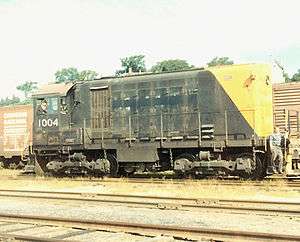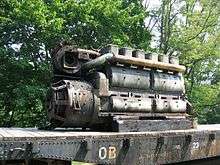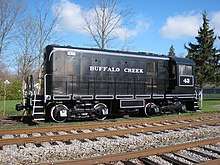ALCO HH series
The ALCO HH series were an early series of switcher diesel-electric locomotives built by the American Locomotive Company (ALCO) of Schenectady, New York between 1931 and 1940, when they were replaced by the S series; the 660 hp (490 kW) S-1 and 1,000 hp (750 kW) S-2. They were ALCO's first diesel switchers to enter true series production, and among the very first land vehicles anywhere to use the revolutionary diesel-electric power transmission.
| ALCO HH series | |||||||||||||||||||||||||
|---|---|---|---|---|---|---|---|---|---|---|---|---|---|---|---|---|---|---|---|---|---|---|---|---|---|
 Portland Terminal Company HH600 #1004, photographed at Portland, Maine in 1968. | |||||||||||||||||||||||||
| |||||||||||||||||||||||||
| |||||||||||||||||||||||||
| |||||||||||||||||||||||||
The "HH" name stood for "High Hood", a name ALCO came eventually to use in an official context, but originally an unofficial name. Model designations such as HH600 are only semi-official. Original ALCO designations were either descriptive or based on the internal order/design number.
A total of 177 of the HH series were produced; this comprised one prototype and four production models of varying power outputs.
ALCO 600 (New Haven #0900)
The first HH series locomotive, ALCO demonstrator #600 was mechanically almost identical to the others, but the appearance differed. The sides of the locomotive's hood sloped outward from top to bottom, and brake equipment was exposed beneath the cab. After a period of demonstration on a number of railroads, the unit was sold to the New York, New Haven and Hartford Railroad who numbered it as 0900, this number often being used to describe the locomotive, although the classification on the builder's data card was "404-OE-200". It rode on a unique pattern of trucks. This first unit was built in July 1931.
Diesel-electric power transmission
The locomotive was equipped with a four-stroke McIntosh & Seymour 531 straight-6 diesel engine, powering a General Electric GT551A1 main generator. Four nose-suspended GE-287-D traction motors in the trucks were geared at a ratio of 4.25:1 to the wheels; the motors were cooled by electrically driven traction motor blowers.[1]



HH600
The HH600 was nearly identical to the previous #0900 of the New Haven internally and mechanically, but it was clad in new bodywork, with a straight-sided hood and cab sides that came all the way to the frame. The HH600 was powered by a 6-cylinder McIntosh & Seymour 531 engine of 600 hp (450 kW), and was built from July 1932 through May 1939; in all, 78 HH600s were constructed. The first-built units had sharp-edged front hood corners, but in 1934 ALCO employed industrial designer Otto Kuhler to clean up the appearance; he curved the corners and recessed the headlight, and all subsequent HH series units were of this style until another restyling in 1938 where the nose was further rounded. Late versions of this locomotive used the 6-cylinder 538 engine.
Original buyers
| Railroad | Quantity | Road numbers | Notes |
|---|---|---|---|
| American Locomotive Company (prototype) | to New Haven 0900 | ||
| American Locomotive Company (demonstrators) | 1 to ATSF 2300 | ||
| to Lehigh Valley Railroad 105 | |||
| to Boston and Maine 1102 | |||
| to Delaware, Lackawanna and Western 401 | |||
| Atchison, Topeka and Santa Fe Railway |
| ||
| Belt Railway of Chicago | |||
| Boston and Maine Railroad | |||
| Central Railroad of New Jersey | 1021 to Houdaille Construction Co. | ||
| Chicago and Eastern Illinois Railroad | |||
| Chicago and Illinois Western Railroad | |||
| Chicago and Western Indiana Railroad | |||
| Delaware, Lackawanna and Western Railroad | 405–406 to Erie Lackawanna as 322-323 | ||
| Elgin, Joliet and Eastern Railway | |||
| Hoboken Manufacturers Railroad | |||
| Illinois Central Railroad | Scrapped 1951 | ||
| Massena Terminal Railroad | |||
| Michigan Limestone and Chemical Company | |||
| New York Central Railroad | Renumbered 800–805 | ||
| New York Central (Boston and Albany Railroad) | Renumbered 806–810 | ||
| New York, New Haven and Hartford Railroad | |||
| Patapsco and Back Rivers Railroad | |||
| Peoria and Pekin Union Railway | |||
| Portland Terminal Company [Maine] | |||
| South Buffalo Railway | |||
| Steelton and Highspire Railroad | |||
| Universal Atlas Cement | |||
| Total | 79 | ||
HH900
The HH900 was a 900 hp (670 kW) version of the HH series using a turbocharged version of the McIntosh & Seymour 531 engine. Both turbocharged models (HH900 and HH1000) needed a greater cooling capacity, and this was reflected in the larger bodyside radiator space of both models, which distinguishes them from the lower-powered HH600 and HH660. The 21 HH900 units were produced between March 1937 and January 1939, after which it was replaced by the McIntosh & Seymour 538T-engined HH1000. Several HH900s were built with the 538T engine.
Original buyers
| Railroad | Quantity | Road numbers | Notes |
|---|---|---|---|
| American Locomotive Company (demonstrator unit) | to CRI&P 730 | ||
| Birmingham Southern Railroad | |||
| Elgin, Joliet and Eastern Railway | |||
| Kansas City Terminal Railway | |||
| Minnesota Transfer Railway | |||
| Philadelphia, Bethlehem and New England Railroad | to South Buffalo Railway 70 | ||
| Reading Company | |||
| Warrior River Terminal Company | |||
| Youngstown and Northern Railroad | |||
| Total | 21 | ||
HH660
The HH660 started production in ALCO's lineup in October 1938; 43 examples were built until April 1940. It used a naturally aspirated version of the 6-cylinder McIntosh and Seymour 538 engine, producing 660 hp (490 kW). Externally, HH660s are indistinguishable from late HH600s.
Original buyers
| Railroad | Quantity | Road numbers | Notes | |
|---|---|---|---|---|
| American Locomotive Company (plant switcher) | ||||
| Atlantic Coast Line Railroad | ||||
| Boston and Maine Railroad | ||||
| Buffalo Creek Railroad | To Relco - 1966, to WNYRHS - 2000 | |||
| Chicago, Milwaukee, St. Paul and Pacific Railroad (“Milwaukee Road”) | Renumbered 980–983
| |||
| Delaware, Lackawanna and Western Railroad | 409–410 to Erie-Lackawanna Railway 324–325 | |||
| Elgin, Joliet and Eastern Railway | 211 to Gopher State Scrap and Metal | |||
| Erie Railroad | 305 to Erie-Lackawanna Railway | |||
| Green Bay and Western Railroad | ||||
| Inland Steel | ||||
| Louisville and Nashville Railroad | ||||
| Maine Central Railroad | ||||
| Minneapolis and St. Louis Railway | To Glacier Sand & Gravel | |||
| New York, New Haven and Hartford Railroad | ||||
| Northern Pacific Railway | 125–126 to Walla Walla Valley Railway 770, 775;
| |||
| Southern Pacific Company | ||||
| Tennessee Central Railway | ||||
| Wabash Railroad | ||||
| Total | 43 | |||
HH1000
The HH1000 replaced the HH900, replacing the 531 engine with the new McIntosh and Seymour 538T engine, turbocharged to produce 1000 hp (750 kW), a 100 hp (75 kW) increase on the previous model. It was produced during May 1939 and December 1940; 34 were built. M&STL D539 was the only HH1000 built with the 531T engine.
Original buyers
| Railroad | Quantity | Road numbers | Notes |
|---|---|---|---|
| American Locomotive Company (demonstrator unit) | |||
| Atchison, Topeka and Santa Fe Railway | |||
| Atlantic Coast Line Railroad | |||
| Birmingham Southern Railroad | |||
| Chicago, Milwaukee, St. Paul and Pacific Railroad (“Milwaukee Road”) | |||
| Manufacturers Railway | |||
| Michigan Limestone and Chemical Company | |||
| Minneapolis and St. Louis Railway | Renumbered 92; to Chicago and North Western Railway | ||
| Missouri Pacific Railroad | |||
| Newburgh and South Shore Railway | |||
| Oliver Iron Mining Company | |||
| Total | 34 | ||
Specifications
| Overall length | 45 ft 2.75 in | 13.79 m |
| Between bolster centers: | 21 ft 3 in | 6.48 m |
| Truck wheelbase: | 8 ft 0 in | 2.44 m |
| Width over grabirons: | 9 ft 10 in | 3.00 m |
| Height above rails: | 14 ft 3 in | 4.34 m |
| Wheel diameter: | 40 in | 1.02 m |
| Fuel capacity: | ||
| Engine (HH600): | McIntosh & Seymour 531 | |
| Power (HH600): | 600 hp | 450 kW |
| Engine (HH900): | McIntosh & Seymour 531T (turbocharged) | |
| Power (HH900): | 900 hp | 670 kW |
| Engine (HH660): | McIntosh & Seymour 538 | |
| Power (HH660): | 660 hp | 500 kW |
| Engine (HH1000): | McIntosh & Seymour 538T (turbocharged) | |
| Power (HH1000): | 1000 hp | 750 kW |
| Main generator: | ||
| Traction motors: | ||
| Standard gearing: | ||
| Weight: | ||
Surviving units
A few HH series switchers still survive in revenue service, and more are in museums. Working HH locomotives include an HH660 at Gopher Scrap in Mankato, Minnesota, one more owned by the Western New York Railway Historical Society, and one owned by Behr Iron and Steel of Portage, Indiana. Preserved locomotives include an HH600, four HH660s, an HH900 and an HH1000.
- Birmingham Southern #82, the sole surviving ALCO HH900, is on static display at the Heart of Dixie Railroad Museum in Calera, Alabama.
See also
Notes
References
- Pinkepank, Jerry A. (1973). The Second Diesel Spotter's Guide. Kalmbach Publishing Co., Milwaukee, WI. ISBN 0-89024-026-4.
- Sweetland, David. (2004) Santa Fe's Alco Switcher Fleet. Diesel Era Vol. 15 No. 6, November/December 2004, pp. 10–31. Withers Publishing, Halifax, Pennsylvania.
- Laundry, Mark. Alco High Hood Models. Retrieved March 29, 2005.
- Komaneski, John. ALCO HH600 Roster. Retrieved March 27, 2005. States information originally from Extra 2200 South.
- Komaneski, John. ALCO HH660 Roster. Retrieved March 27, 2005. States information originally from Extra 2200 South.
- Komaneski, John. ALCO HH900 and HH1000 Roster. Retrieved March 27, 2005. States information originally from Extra 2200 South.
- Steinbrenner, Richard (2003) The American Locomotive Company A Centennial Remembrance. Chapter VI subchapter "ALCO's First Production Diesels".